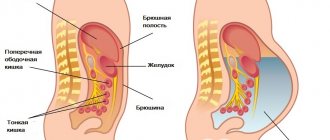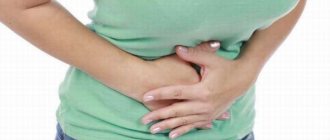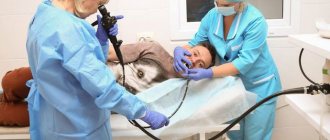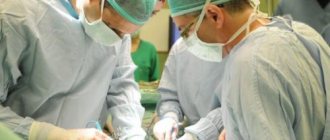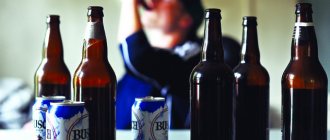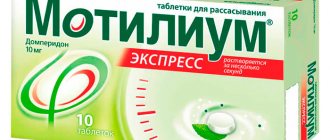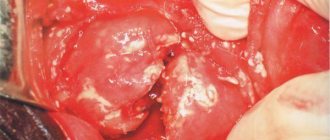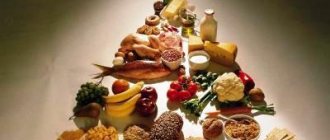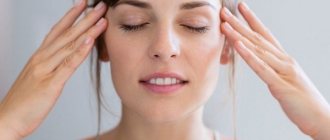Pancreatitis is a disease of the inflammatory process of the pancreas, which has a significant impact on the general condition of the body, bringing disruption to the human digestive tract. The main problem with this pathology is the partial or complete cessation of access of pancreatic juice and secreted enzymes to the small duodenum. Collecting in the ducts, digestive juice, unable to escape due to the blocked duct by the sphincter, causes inflammation of the gland, which causes mechanical damage to the walls of the organ.
pancreatitis in men
The digestive composition secreted by the gland during accumulation enters into a chemical reaction with the contents of the intestine and is activated, which leads to the gradual digestion of the walls of the duct and pancreatic tissue. At the same time, the body exhibits symptoms of pancreatitis in men and women, which come in chronic and acute forms.
Classification
Just like many other diseases, pancreatitis can be acute and chronic; in addition, there is a reactive form - this is pancreatitis, which develops as a result of diseases of other organs of the digestive system.
In turn, each of these forms can be mild, moderate and severe. The border between acute and chronic forms is quite blurred. With exacerbations less than once every six months, pancreatitis is considered chronic, but if they occur more often, it is considered acute recurrent.
What kind of male patients are they?
When making treatment appointments, medical professionals often note differences between patients. Female patients, as a rule, follow the doctor's recommendations more conscientiously. They take a responsible approach to dieting. The patient is required first of all to eliminate the cause that led the body to the disease. Completely stop drinking alcoholic beverages and adjust your diet.
The diet should be complete in protein and vitamin composition. Nicotinic acid and B vitamins are indicated. Protein products (mashed cottage cheese, chicken, veal) predominate in the diet. Spicy and fatty foods are excluded, regardless of culinary tastes and gastronomic preferences.
Some men refer to the inability to carry out regular split meals at the workplace (5-6 times a day). To a greater extent, this is a psychological problem - the disorganization of a patient who is in remission. Replacement administration of enzymes (pancreatin, pancitrate, creon, festal) is also necessary.
Male patients are reluctant to use traditional medicine recipes as aids. Preparing infusions requires some time and skill. Smoking aggravates the development and complicates the treatment of pancreatic diseases. According to statistics, the percentage of men who smoke is higher.
The pancreas is an important organ that produces digestive enzymes and hormones that control carbohydrate metabolism. Pancreatitis (inflammation of this gland) develops for various reasons. More often, adult men suffer from this pathology: this is due to their less commitment to a healthy lifestyle, proper nutrition and neglect of their health. Symptoms of inflammation of the pancreas in men depend on the cause of the disease, the stage of the inflammatory process, and the severity of damage to the organ.
Causes of pancreatitis
The main cause of the disease is alcohol abuse. Its excessive doses negatively affect the normal functioning of many internal organs, including the pancreas. But there are many more reasons due to which pancreatitis can develop:
- cholelithiasis;
- previous infectious and other diseases;
- complications due to surgery;
- taking medications with side effects that affect the gastrointestinal tract;
- heredity;
- severe allergies.
That is, against the background of other diseases, pancreatitis begins to develop as a complication. Therefore, all diseases must be treated in a timely manner.
Diagnosis of the disease
To detect pancreatitis, the doctor conducts a detailed survey of the patient. At this stage, the possibility of a congenital disease is excluded. After which the patient must undergo the following studies:
- General analysis of urine and blood. Required to detect inflammatory processes in the body.
- Ultrasound of the peritoneum. Determines whether there are stones in the gall bladder and the general condition of the internal organs.
- CT scan. Helps identify affected areas of the pancreas.
Based on the results of the measures taken, the specialist doctor makes a diagnosis and prescribes a specific treatment.
Important! You can learn about the symptoms and treatment of pancreatitis in children here.
Symptoms and signs
The most important of all manifestations of the disease, sufficient to make a diagnosis of “acute pancreatitis,” is acute girdling pain that occurs in the left hypochondrium and spreads across the upper abdomen.
The pain can be felt in the back under the left shoulder blade and intensifies in a supine position; it is not relieved by antispasmodics.
- Nausea and vomiting,
- Loose stools that acquire a clayey consistency due to undigested fat,
- Fever and general weakness,
- Loss of appetite,
- In case of obstruction of the bile ducts - obstructive jaundice,
- Skin rash.
With a chronic inflammatory process in the pancreas, the patient may not be aware for a long time of what is causing problems with well-being and digestion.
- Pain in the left hypochondrium that occurs after eating fatty, heavy foods,
- Diarrhea, clayey sticky feces, increased gas formation,
- Nausea, putrid belching, sudden weight loss,
- Unreasonable hostility to certain types of food.
Varying pain pattern and stone formation tendency
According to statistics, the acute form is most often found in young men, the chronic form - in older women. The main complaint of a patient with chronic pancreatitis is pain not only in the epigastric region, but also in the periumbilical region. The gland is located in the abdominal cavity: from the hypochondrium on the right down to the navel. The nature of the pain is dull and aching. The patient experiences sensations of discomfort and fullness in the upper abdomen.
The pain intensifies each time after:
- errors in diet;
- drinking alcohol;
- eating fatty foods;
- overeating.
Seizures occur against the background of constant dull pain. Then severe pain in the epigastric region takes on a girdling character. In intensity it does not differ from that observed in acute pancreatitis. Some patients mistake pain radiating to the back for an angina attack. Among the first manipulations with the patient, specialists are required to perform an electrocardiogram of the heart.
Spasms are combined with pain on palpation in the gastric region (stomach area). A person is worried about a decrease in appetite and, as a result, sudden weight loss. Nausea in eight out of ten cases ends in vomiting. The symptom may not be associated with food intake or may be caused by foods such as mushrooms, tomatoes, honey.
Chronic pancreatitis of alcohol origin occurs most often in people who have been addicted for a long time. In men it usually develops after 10 years of systematic abuse, in women it develops faster – after 6–7 years. The symptoms of the female and male bodies are similar.
Characteristic signs of pancreatic disease include stone formation. This is explained as follows: the protein content in pancreatic juice increases. According to existing medical statistics, gallstone disease is more common in women.
Experienced doctors can palpate lumps on the pancreas. But the correct evidence base for establishing an adequate diagnosis is provided by ultrasound examination of the organ. Ultrasound clearly shows pathological formations and their cystic nature. Changed cells can provoke gland cancer.
Diseases of the gland are aggravated by bacterial infections in the abdominal cavity and internal bleeding of organs. In this case, the symptoms include high temperature, decreased blood hemoglobin, and weakness.
The following external signs are distinguished:
- alternating loose stools and constipation;
- pallor or yellowness of the skin;
- excessive salivation;
- tachycardia (rapid heartbeat - more than 100 beats per minute).
The pancreas also produces the hormone insulin. Often, damage to organ tissue leads to insular failure. The danger is that they are hidden. Intoxication of the body serves as evidence of an ongoing hormonal disorder of carbohydrate and fat metabolism.
This causes dehydration:
- 1st degree (weak thirst, slightly increased respiratory rate);
- 2nd degree (moderate thirst, dry mucous membranes, the volume of urine excreted decreases, it becomes darker in color);
- 3rd degree (extreme thirst or no thirst at all, slow reactions of consciousness, speech, decreased blood pressure, ketoacidosis - the appearance of ketone bodies in the urine).
To identify a diagnosis for outwardly mildly manifested symptoms of diabetes mellitus, it is necessary to carry out tests with a carbohydrate load (glucose). The patient may need to continue insulin therapy.
Symptoms of pancreatitis of the pancreas
When prescribing tablets for the liver and pancreas (PG), the doctor takes into account their pharmaceutical effects in order to achieve the therapeutic goal faster and more effectively.
Namely, drugs for inflammation of the liver and pancreas are prescribed:
- Baralgin, No-shpa, Spazgan, Papaverine - for an analgesic effect: reducing acute pain and spasms;
- Enzyme forte, Creon, Pancreatin, Festal - to compensate for enzyme deficiency: facilitating the functioning of the digestive system and eliminating the inflammatory process;
- Almagel, Maalox, Phosphalugel - to neutralize the aggression of acidic secretions: to prevent further destruction of the tissues of the digestive organs;
- Ampicillin, Doxycycline, Tobramycin, Cefspan, Cephobid - to inhibit pathogenic bacteria: reduce inflammation and swelling.
In case of exacerbation, call an ambulance and inject No-shpu into the muscle to eliminate spasms in the pancreatic ducts. In this case, the patient should sit down, pressing his legs to his stomach and tilting the front part of his body slightly forward to reduce pain and muffle attacks of nausea. A cold compress is applied to the epigastric area and left for 10-15 minutes.
Means to maintain pancreatic function
Chronic inflammation is eliminated and the functioning of the pancreas is supported by enzyme preparations: Almagel A, Creon 1000, Mezim, Maolox. Restore digestive functions and normalize intestinal microflora by administering Lacton, Linex or Lacidofil with or after food.
If we consider medications for restoring the liver and pancreas, the list of painkillers and enzymatic agents also includes: Pancreatin, Panzinorm, Digestal, Lycreaz, Creon, Festal and Enzistal. Medications that normalize the concentration of enzymes during exacerbation of the pancreas: Digestal, Lycreaz, Creon and Festal. They restore the functioning of the pancreas and digestion, and prevent subsequent relapse.
From this list, bile contains the following drugs: Festal, Ferestal and Enzym forte. These drugs are used to treat pancreatitis, but they are prohibited for stomach and duodenal ulcers, gastritis and cholelithiasis.
Mezim and Pancreatin contain enzymes: amylase, protease and lipase, so they cannot be taken for a long time so as not to cause pancreatic dysfunction. Heptal and Allahol increase the secretion of liver cells, so they are often prescribed for pancreatitis.
Pain syndrome during inflammation of the pancreas is eliminated with the following pharmaceuticals: Gastrocepin, Platyfillin, Atropine, Baralgin. If the patient cannot tolerate the pain, then use narcotic drugs - Tramal or Promedol.
Analgesic for pain relief due to inflammation of the pancreas
To get rid of pancreatic diarrhea, the following medications are prescribed for diseases of the pancreas and liver:
- Bactisubtil - 1 capsule orally 3-6 times a day, up to 10 capsules - for relief of severe diarrhea, contraindicated - in case of hypersensitivity to the components of the drug;
- Regidron - 10 ml/kg after each attack of diarrhea. Contraindicated in arterial hypertension, diabetes mellitus, acute renal failure and chronic renal failure, excess potassium;
- Tannacomp - 1 tablet 4 times to eliminate diarrhea and 1 tablet - 2 times for prevention. Pregnant women should take with caution after consulting their doctor.
Diarrhea remedy
If bile is released during persistent vomiting, then treatment is carried out with a medicine for the liver and pancreas such as Metoclopramide, Metukal or Cerucal.
If intraductal pressure in the pancreas increases and the productivity of pancreatic juice increases, acute pain occurs in the upper part of the peritoneum, and the acid-base balance is disturbed.
At the same time, unnatural processes are activated in the stomach, to stop which antacids are prescribed: Acyloc, Getrocalm, Zantac, Omez. Patients take them for several days to get out of a critical condition.
Antacid for acid-base imbalance
Also, gastric problems occur with long-term treatment of pancreatitis, since excessive amounts of hydrochloric acid are produced. Tablets for the stomach and pancreas reduce acidity and improve the digestion process; the list includes: Almagel, Omez (Omeprazole), Maalox, Phosphalugel.
To quickly cleanse the body of toxins, activated carbon or Enterosgel is prescribed. For bacteriosis and inflammation of the pancreas, take Smecta, and for impaired intestinal motility - Trimedat.
Remedies for heartburn and improved digestion
Antienzyme (antisecretory) agents. During an exacerbation, the pancreatic parenchyma tends to swell, so its ducts narrow. And again, the outflow of pancreatic juice is disrupted, while the pancreas still synthesizes digestive enzymes. Their production can be blocked with antienzyme drugs: Nizatidine, Famotidine, Esomeprazole, Cimetidine.
Histamine H2 receptor blockers and proton pump inhibitors are used as antisecretory (antienzyme) and pain relievers. The most popular tablets for the treatment of the pancreas are: Gordox, Omeprazole, Esomeprazole, Nizatidine, Lansoprazole, Rabeprazole and Cimetidine.
Nonsteroidal anti-inflammatory drugs are prescribed to normalize temperature, reduce inflammation and pain. NSAIDs: Aspirin, Diclofenac, Ibuprofen can reduce the risk of general intoxication of the body
So, to relieve inflammation, heat and pain, treatment is carried out:
- Aspirin – 4 g/day. Contraindicated in case of cardiac, renal and liver failure, hemorrhagic diathesis, asthma, ulcers, in combination with Methotrexate;
- Diclofenac tablets - 50-150 mg/day in 2-3 doses. Cannot be used during pregnancy, lactation, hypersensitivity, destructive-inflammatory pathologies of the gastrointestinal tract, diseases of the hematopoietic system, ulcers;
- Ibuprofen – up to 6 tablets/day. Contraindicated in case of allergies to components, severe heart failure, renal-hepatic dysfunction, gastrointestinal bleeding and ulcers, in the 3rd trimester of pregnancy.
- If a bacterial infection is added to the inflammation of the pancreas, cholecystopancreatitis develops, then treatment is carried out with broad-spectrum antibiotics: Ampicillin, Bactrim, Kanamycin, Olethrin, Sigmamycin and probiotics to maintain beneficial microflora in the intestines.
Medicines for the treatment of the pancreas improve the release of pancreatic juice and relieve spasms in the pancreatic ducts: Bendazole, Bencyclane, Mebeverine or Platiphylline.
Since it is necessary to support the liver, and chronic pancreatitis is difficult and even impossible to cure, a medicine for the treatment of the pancreas and liver restores tissue, such as:
- herbal preparation Pancretinol with extracts of anise, elm, goldenseal, mint, chamomile and fennel. Dose – 1 tablet/day for a course of 30 days;
- Bifidumbacterin with sucrose, live bifidobacteria, skim milk, edible gelatin. Take 30 minutes before meals according to the dosage indicated on the package;
- Hilak Forte - for dyspeptic disorders and to improve overall well-being, restore beneficial microflora and normalize the acid-base balance. Dose – 50 drops – three times a day, the course is prescribed by the doctor individually.
Lipomatosis develops due to the replacement of normal pancreatic cells with fat cells. This is how the organ reacts to abnormal transformations, i.e. fatty infiltration becomes not a cause, but a consequence of pancreatitis (inflammation). Fatty infiltration of the liver does not occur in all patients with pancreatitis, but only in those who are obese.
Fatty degeneration of both organs occurs due to:
- inflammatory process in the pancreas;
- blood circulation disorders due to the formation of ischemic and necrotic areas;
- pancreatic injury;
- chronic alcohol intoxication (alcoholism);
- disturbances in the absorption of sugar in the blood;
- deficiency of thyroid hormones;
- obesity of patients;
- poor nutrition;
- chronic diseases.
I would like to note that pills for fatty liver and pancreas have not yet been developed.
The following drugs help get rid of the negative symptoms of obesity:
- eliminates pain – Ibuprofen;
- corrects the digestive process - Pancreatin 8000;
- eliminates diarrhea – Loperamide;
- relieves nausea - Metoclopramide;
- eliminates spasms in the gastrointestinal tract - Mebeverine.
Decoctions of calamus, chamomile, immortelle and sage improve liver and pancreas function at home. If necessary, in severe cases, surgical excision of lipid tissue in the pancreas is performed. But this is a temporary measure, since the fatty tissue is soon replaced by scar tissue.
Maintaining a healthy lifestyle and diet will keep your pancreas and liver healthy
The symptoms of pancreatitis in men are similar to those that affect women. The differences depend on the form of the disease and the degree of damage to the pancreas. Most often accompanied by the following ailments:
- pain in the abdominal cavity of a sudden nature;
- fever and increased body temperature;
- persistent nausea;
- periodic vomiting that does not lead to relief;
- excessive gas formation;
- constipation or diarrhea;
- sudden weight loss as a result of poor appetite;
- allergic manifestations on the skin in the form of a rash;
- general weakness of the body;
- damage to the central nervous system.
Pain in the upper abdomen appears after eating food or large amounts of liquid. Chronic pancreatitis is accompanied by aching, dull pain for several hours. As for exacerbation, the pain has the character of sharply appearing spasms.
Traditional medicine tips
Modern medicine does not prohibit, rather, on the contrary, it recommends the use of traditional medicine to treat pancreatitis in men. Its use is effective in complex therapy, during a diet. But prescriptions will not provide adequate relief and will not get rid of the disease if used alone. Herbal decoctions and infusions are effective as prophylactic agents. Thus, traditional medicine recommends using the following herbal ingredients:
- chamomile;
- St. John's wort;
- yarrow;
- horsetail;
- mint;
- calendula;
- plantain;
- corn silk;
- linen;
- nut leaves.
All these herbs or herbal preparations containing them can be found in any pharmacy. The main thing is that the proportions indicated on the packaging are observed.
Important! Never buy herbs from spontaneous markets. No one knows from which zone they were brought, and whether the rules for collecting medicinal herbs were followed.
Kvass Bolotova
The basis of kvass is celandine. It is necessary to strictly adhere to this recipe, since the plant is poisonous in large doses. Celandine juice contains vitamins, flavonoids, tannins, mucus, organic acids, and alkaloids. This determines its high healing properties. Medicines based on this plant:
- relieve spasms;
- calm the nervous system;
- eliminate pain;
- have choleretic and diuretic properties;
- have a beneficial effect on the formation of gastric juice.
Symptoms of pancreatitis in men with alcoholism
Alcoholic pancreatitis is a disease caused by the harmful effects of ethyl alcohol on the pancreas. Inflammation leads to disruption of the functioning of this organ. Men aged 30 to 50 years who suffer from alcoholism are usually affected. The following signs appear:
- weight loss;
- loose stools;
- frequent belching;
- nausea leading to vomiting;
- cramps in the abdomen after eating food.
There are 2 forms of pancreatitis: acute and chronic. The acute form of the disease is accompanied by very severe pain that appears suddenly. During this period, body temperature rises sharply, heart rate increases, and blood pressure changes. Symptoms of chronic pancreatitis are sluggish and appear progressively. An advanced chronic form can cause jaundice and skin rashes with changes in color. Diabetes mellitus also develops.
Very often, men with pancreatitis are bothered by sleep disturbances, irritability, fatigue, apathy, etc.
How to recognize the disease and symptoms?
Signs of inflammation of the gland in acute form are more distinct. In the chronic form of the disease they are insignificant and blurred. It is men who suffer mainly from the chronic form of the disease as a result of frequent alcohol consumption. In women, in most cases, an acute form of the disease is detected.
The most characteristic signs of inflammation are spasms, pain in the upper abdomen, under the stomach. In the acute course of the disease, the pain is cutting until the position changes. In the chronic stage of the disease, the pain is aching for a long time, but not severe. Unpleasant symptoms of inflammation in the form of cutting pain, shortness of breath, sticky sweat, increased heart rate usually appear half an hour after eating food: sour, spicy, fried. The pain can be constant or paroxysmal; often the symptoms of this gland disease are a mask of development, manifestations of a heart attack, and pathological changes in the stomach. Lying on your back, the pain intensifies; in a sitting position, bending forward, the pain decreases.
Increased gas formation with pancreatitis
Maybe:
- temperature rise to high levels, often febrile;
- increased flatulence;
- nausea, vomiting;
- rashes on the body;
- dizziness, tremor;
- diarrhea or constipation;
- lack of appetite, poor digestibility of food taken, resulting in weight loss and weakness in the body;
- the appearance of yellowness on the skin.
Prevention
It is worth remembering that chronic diseases are easier to prevent than to live with them. Basic measures will help prevent the development of pancreatitis, the main one of which is a healthy lifestyle.
Quitting alcohol and proper nutrition in themselves practically eliminate the entire risk, of course, if there are no other factors leading to damage to the pancreas. Timely treatment of other gastrointestinal diseases and vaccinations against infections that can trigger an autoimmune process are also important.
Therapeutic measures for the formation of pseudocysts
There are several leading principles for the treatment of any pathology of the pancreas, which include:
- diet according to Pevzner (table No. 5);
- pain relief;
- removal of intoxication phenomena;
- the use of pharmacological drugs that suppress the activity of the function of the affected organ.
If the process is complicated by the penetration of pathogenic microflora, antibiotics are prescribed.
At this stage, a decision may be made to perform external percutaneous drainage of the cyst and install a catheter through which the contents are aspirated and the cavity is washed with antiseptic solutions.
Percutaneous drainage of a false cyst
If the tumor grows significantly and puts pressure on neighboring organs, internal drainage or removal of the affected part of the gland is used.
In case of fusion of the false cyst with the posterior wall of the stomach, endoscopic cystogastrostomy is performed.
In most cases, doctors do not predict the outcome of the disease until the patient has fully recovered after surgery, since the mortality rate for this pathology is at least 50%.
Methods for treating pancreatitis
Treatment of the disease depends on its form. The methods of influencing the body differ. Acute pancreatitis is treated using the following steps:
- taking drugs intravenously to cleanse the blood of toxins;
- drugs to relieve pain symptoms (Analgin, Spasmol);
- medications that promote the destruction of pancreatic enzymes - Kontrikal, Gordox and their analogues;
- hormones of the gastrointestinal tract - Somatostatin, Dolorgin and others;
- drugs that stop gagging;
- antibiotics.
During the treatment of the acute form of the disease, the patient completely stops consuming food and liquids orally for 5 days. This is required to unload the pancreas. Nutrition must be given intravenously. After this, you should adhere to a strict diet. It is also necessary to rinse the peritoneum. As for surgical intervention, it is required in extremely severe cases - when removing infected pancreatic tissue.
The period of hospital treatment for acute pancreatitis depends on the severity of the disease. Usually takes up to 4 months.
Treatment of the chronic form of the disease is similar to the effect on acute pancreatitis. Only the main task is to weaken the secretion of gastric juice. For the comprehensive fight against chronic disease, the following means are used:
- Drugs to relieve spasms in the pancreas. For this, the following medications are used: Papaverine, No-shpa, Spasmol.
- Medicines that reduce the secretion of gastric juice. These may be: Gastrozol, Duoran, Ranitin, Altramet, Kvamatel and many others with a similar composition.
- Means for normalizing the digestive process. You can use Allohol, Holonerton, Creon, Mezim, Enzistal and many others.
Pancreatitis in its early stages can be treated with homemade medications. Traditional medicine recipes are used for this.
Stages of formation of false cysts
The formation of a pseudocyst cavity is a fairly long process, occurring in 4 stages. During this time, the body tries to block the development of pathology and stop the process of growth of this formation.
- At the first stage, an initial cavity is formed in the infiltration zone of the parenchyma of the organ, which does not have clear boundaries. This phase lasts about six weeks.
- At the second stage, the walls of the cavity begin to be lined with connective tissue, forming a capsule, inside which the processes of melting the affected cells continue. The duration of the phase is from 2 to 3 months.
- The third stage is characterized by the enveloping of the connective tissue capsule with fibrin fibers, the formation of which ends 6 months from the onset of the disease.
- The fourth stage is characterized by hardening of the fibrinous tissue and its separation from the surrounding parenchyma.
Pseudocysts differ in location, stage of formation and internal contents
At any stage of development of false cysts, suppuration, perforation, formation of fistulas, and degeneration into a malignant formation can occur.
